Three Weeks in Heaven (Part 1)

Barry Taylor is originally from England but now lives in West Ireland. A fan of British Real Ale, he has found the Continental equivalent in the Zoigl beers of the Oberpfalz.
This is a report from a visit in 2007 so some of the information will have changed., but we'll soon have an update from Barry.
Introduction
I’m not quite sure what first alerted me to the potential attractions of Windischeschenbach. Probably first was the entry in Steve Thomas’ ‘bible’, reinforced by the description of a visit by the late John White in 2006 and, finally, occasional mentions on the Frankenbier forum. Whatever, when we found ourselves bored by the somewhat obvious delights of Regensberg on a visit in May 2009, Jacqueline and myself decided to invest in a Bayern ticket and take a day trip to ‘Eschawo’, as it is known to its inhabitants.
Although the rail journey is pleasant (I love the Vogtlandbahn – surely one the most impressive and efficient small railways in Europe), with the area becoming increasingly rural, first impressions of Eschawo are not great. As in many German rural locations, the station is crumbling into dilapidation, while the huge, deserted porcelain factory does little to improve the image of the town. The walk up the hill to the town is unremarkable, with the first sign of beer life being Würth’s brewery and pub after a kilometre or so. After crossing the Neuhaus road, you enter the main street (Hauptstrasse). A few hundred metres later, you come across the Rathaus, with the Zoigl calendar conveniently posted outside. The only downside to this arrangement is that there is no map showing the locations of the different Zoiglstube, which can be tricky to find. Certainly, on our first visit, we had problems finding Zoiglstube Schlosshof, which is quite tucked away, and it is not unusual to find the town seemingly bereft of human life. Of course, if you are sensible, you are carrying a copy of the Zoigl stube map that is available on the town’s Zoigl website.
Like so many of the Zoigl venues, Schlosshof is like a cross between drinking in someone’s house and a conventional Bayern pub. There is a delightful small beer garden and room containing long tables and benches. We really liked Schlosshof, the beer was delicious and cheap (if my memory serves me correctly, €1.50 a seidla), and the atmosphere friendly and appealing. After a couple of Zoigls, we headed out if town and up the hill to Neuhaus – a short but strenuous walk up the hill past the Burg. Open that day was Schoilmichel, home of Manfred Punzman. Not unlike Schlosshof, the atmosphere was most hospitable, with several people attempting conversation, in the usual mixture of my poor German and their equivalent English. The beer was a little different from that of Schlosshof (more of this later) but at a similar price.
All in all, we really enjoyed our day trip to Windischeschenbach/Neuhaus and the experience sparked the idea of a longer visit. Rather than bore everyone with a detailed travelogue of three weeks in Eschawo, I’ll confine my comments to the Zoiglstub’n visited and matters directly connected to Zoigl. I’ll try to describe the pubs first and then make a general summary of the beers and breweries.
Windischeschenbach
Weisser Schwan
We arrived around 9 p.m. on a Wednesday – not the best time or day for Zoigl in Eschawo and headed for Loistl only to find it securely closed! Wednesday is also the Ruhetag for the hotel, so, after a bit of aimless and despondent walking, we managed to locate the Gasthof Weisser Schwan. Apart from a group gathered around one table, there were only a couple of other customers but we order a couple of Zoigls and settled back to enjoy. The Schwan is not a Zoiglstube and I’m not sure from whom it buys its Zoigl but it was satisfactory and a couple more were swiftly ordered. After a while, a man who spoke good English and who introduced himself as ‘Ludwig’ approached us. This turned out to be Ludwig Lindner, who befriended the late John White on his first expedition to Eschawo in 2006. Ludwig is a very interesting character who speaks excellent English (and probably a number of other languages) and who served on cruise ships for more than 30 years. He seems to act as a sort of unofficial Zoigl guide for foreign visitors and, as John White commented, is an excellent source of information and a most congenial companion. Ludwig commented that Loistl had mainly a very local clientele and, if it emptied by a certain time, it was not unusual for the place to close.
Brandl
This is the tap of Würth’s brewery. As others have pointed out, this is not a stimulating experience – the room is stark and uninviting and the service similar. It seems bizarre to be served beer from a bottle when you’re in the brewery tap but that’s how our Hell Zoigl came. Not that it was particularly bad, but there seemed little reason to hang around. So we headed for Zoiglschänke Loistl – the first of many visits
Zoiglschänke Loistl
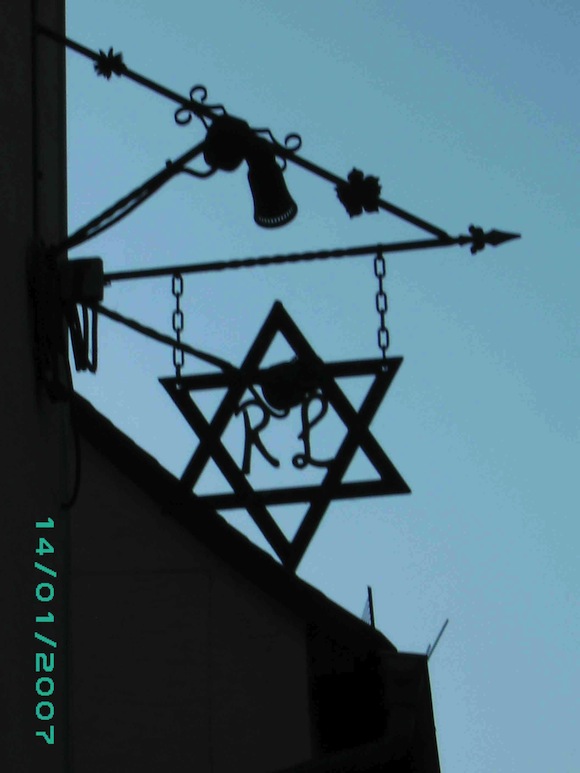
Loistl Sign
To find Loistl, you must look for the Zoigl star on Neustädter Strasse and then turn into Dammstrasse. A few metres on the left you will find Loistl, completely unsigned but easily recognisable as a pub. Sometimes, you enter via the main entrance, sometimes via a side door – not sure why. Inside, the light is often a little dim and the room is quite small. Most of the action takes place around the Stammtisch at the far end. I say ‘Stammtisch’ but, to be honest, there is nothing to preclude anyone sitting there. It is just the most convenient place for the ausschänke and the place where the regulars congregate. I have drunk in many bars in many parts of Europe but can honestly say that I have never met a more welcoming landlord and landlady than Rudi and Anni Loistl or a more friendly and welcoming set of regulars.
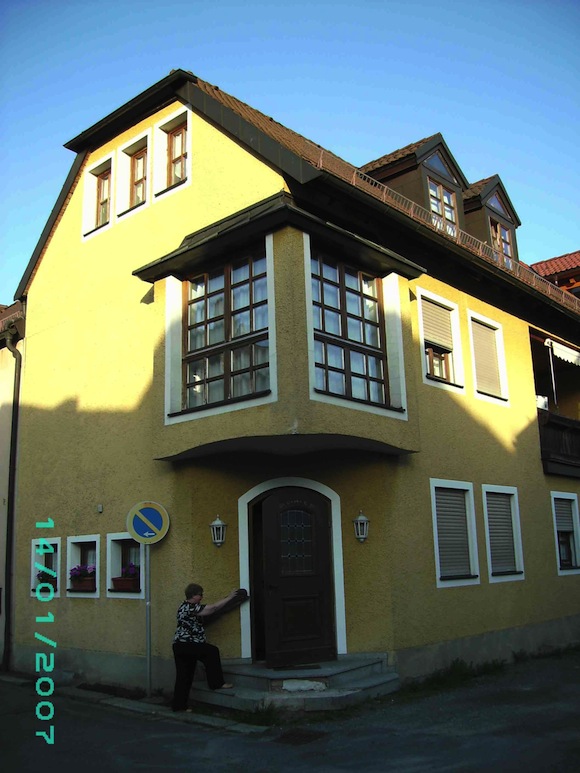
Loistl Exterior
From the literature on Zoigl, it is possible to get the impression that Loistl is not part of the ‘Kommunbrauerei’ set up. This is probably because it opens on weekdays and is not part of the weekend rota. However, like the other stub’n, Rudi brews his own beer, which he sells in Loistl Windischeschenbach and the Loistl’s other pub in Altenstadt (Alter Pfarrhof), which opens from Friday to Monday, on the first weekend of each month. Incidentally, on that Monday, Loistl’s Eschawo is closed.
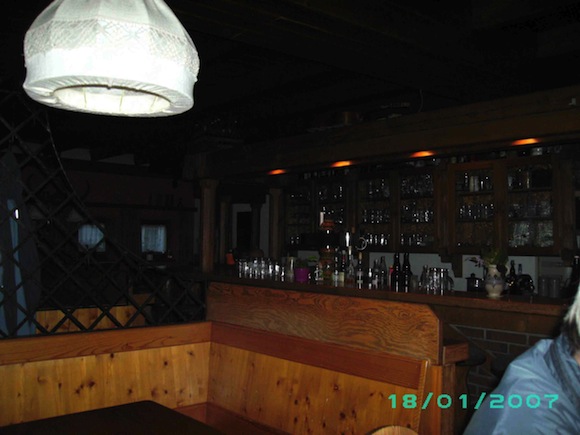
Loistl Interior
Living in the West of Ireland, we found it a little difficult to get used to the drinking habits in Eschawo. I am used to late night sessions (I don’t usually get into my local much before 10.30 p.m.) but things in the Oberpfälzer Wald are a little different. Loistl’s opens at 5 p.m. and is probably at its busiest until around 9 p.m. However, it wasn’t so difficult to get used to the cost of drinking: at home, I’m used to paying anywhere between €3.60 and €4.00 for a pint of Guinness. I must admit to a degree of uneasiness as the seidlas of echter Zoigl slid down and the marks mounted on the beer mat. However, at €1.60 a throw, it was hard to rack up a bill over much over €10 for a night - and that was for two of us.
Although the term ‘schnitt’ is known in the town, a small measure (usually well over 25-cl) is referred to as a ‘Pfiff’ – generally signaled by a whistle in Loistl’s.
Beim Binner
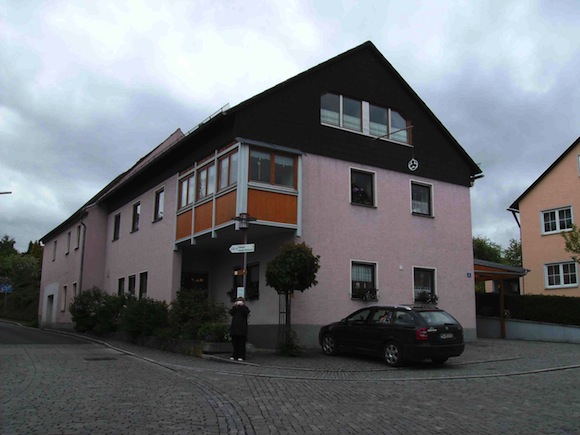
Binner Exterior
This is the stube of Robert Sperber and family. Robert is a most hospitable and friendly man who was most anxious to talk with us. Unfortunately, his grasp of English and my atrocious German only allowed cursory exchanges. Still, he made us most welcome. Binner is quite a large and professional establishment and is noted for its food. From opening on Friday morning, it was crowded both inside and outside but it was always possible to find a seat somewhere, with people squeezing up to make this possible at times. Robert told me that it was almost impossible to make a full-time living from the Zoiglstube and it is necessary to have another job (I gather that he is also an undertaker – a common second job for publicans in rural Ireland). Robert brews around 10 times per year and sells around 1,800 litres per weekend (four days). He also makes delicious schnapps from a variety of fruits.
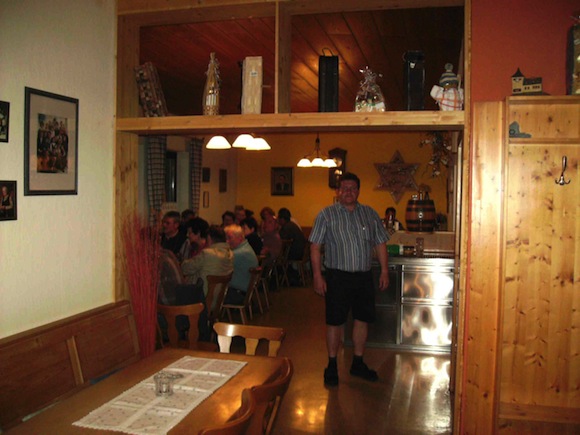
Robert Sperber
Binner is one of the bigger Zoiglstube and it is possible to hire the premises for private parties (with Zoigl provided, of course!).
Zum Roud’n
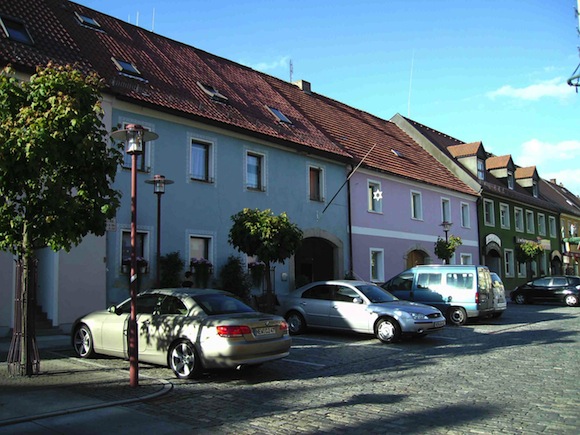
Zum Roud'n Exterior
From one of the biggest to one of smallest stube – the family Heinl’s establishment in the Stadtplatz, right in the centre of Windischeschenbach.
Perhaps because it is small and perhaps because Anton and Frau Heinl are most friendly and welcoming hosts, Zum Roud’n became one of our favourite stube. Entering through its arched doorway, you quickly enter the small beer garden. The ausschänke is situated to the left of the entrance courtyard and, more than any other Zoiglstube, is probably reminiscent of the origins of this ancient tradition. I believe that the Antons use the inner section of the ausschänke as part of their domestic accommodation when the stube is closed. Both Anton and Frau Heinl speak good English and we were able to derive much information on the history of Zum Roud’n and the Zoigl tradition in general. When you look at Zum Roud’n today, it is hard to believe that this was once a farm, its land stretching out at the rear, where there is now a housing estate. In Anton’s father’s time, the farm was self-supporting and the main customers for the stube were the farm workers.
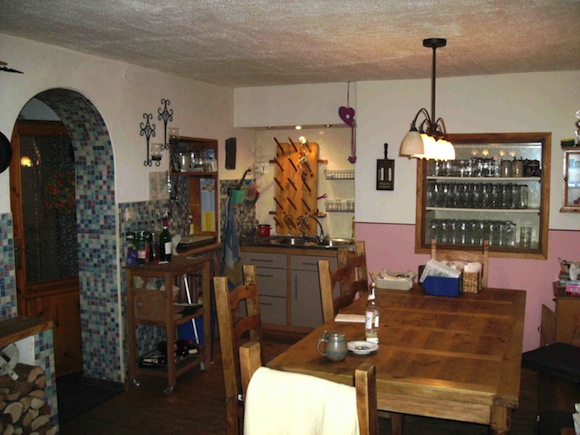
Zum Roud'n interior
Anton has just retired as leader of Kommunbrauerei, which operates as a co-operative, with costs shared between its users. Sadly, he is pessimistic about the future of his stube, as none of his children are particularly interested in this aspect of the business. Nowadays, Anton, Frau Heinl and a daughter also operate a business making decorative glass (you can see some of his work in the local graveyard!). He is of the view that the future is uncertain for all the Zoiglstube, which tend to rely on visitors from outside the town to keep them going.
Zum Roud’n is one of the smaller brewers, usually brewing around three times a year. We were able to sample two different brews – one that was brewed in February and one that was brewed in May. I was a little skeptical that he was able to maintain quality over a fairly long period but he told that this was achieved by reducing the storage temperature to 4° Celsius and using a blanket covering of carbon-dioxide. Now, I am highly sensitive to the latter and (following strict CAMRA edicts!) highly disprove of this practice in general. However, I must say that only a faint taste of CO2 could be detected and it did little or nothing to detract from the flavour, making Anton’s beers one of our Wind/Neuhaus favourites. It is worth noting that, as far as I am aware, all Zoigl-stub’n in Wind/Neuhaus use CO2 to deliver their products but the way that it is used seems to vary considerably.
Wolframstub’n
I can’t resist commenting that this stub’n is really a wolf in sheep’s clothing! Sorry! OK, the justification is that, although claiming to be a Zoigl-stub’n, it is actually a self-contained microbrewery selling a product that is almost identical to ‘echter Zoigl’. In the past, they used the Kommunbrauerei and I don’t know the reason that they departed from that practice, although dark mutterings in Eschawo suggested a falling out among friends. To be fair, they do state they are a brauerei and they are not listed as providing ‘echter Zoigl’ from the ‘Kommunbrauerei’ in the Zoigl information packs. In fact, as John White comments, their Zoigl is pretty much as that of the ‘echter Zoigl’ establishments, although it was one of the ‘gassier’ (i.e. more detectable CO2 used for delivery) of the beers tasted. It also seems lighter in taste and colour, which suggests a higher proportion of pilsner malt (more on these matters later). The stub’n is quite small, set out in fairly standard Bavarian long-table manner. Wolframstub’n seem to make a habit of arranging ad-hoc openings, such as the one-day ‘backoffenfest’ held whilst we were in town. Like the other stube, their premises and Zoigl are available for private parties.
Whilst not being my favourite Zoigl, I must say that it was highly enjoyable to drink whilst sitting in the lovely garden of new found friends from Loistl’s stammtisch, Joylanthe and Sepp, (which is situated opposite Wolfram) on a beautiful summer’s evening!
Continue on to Part II.
